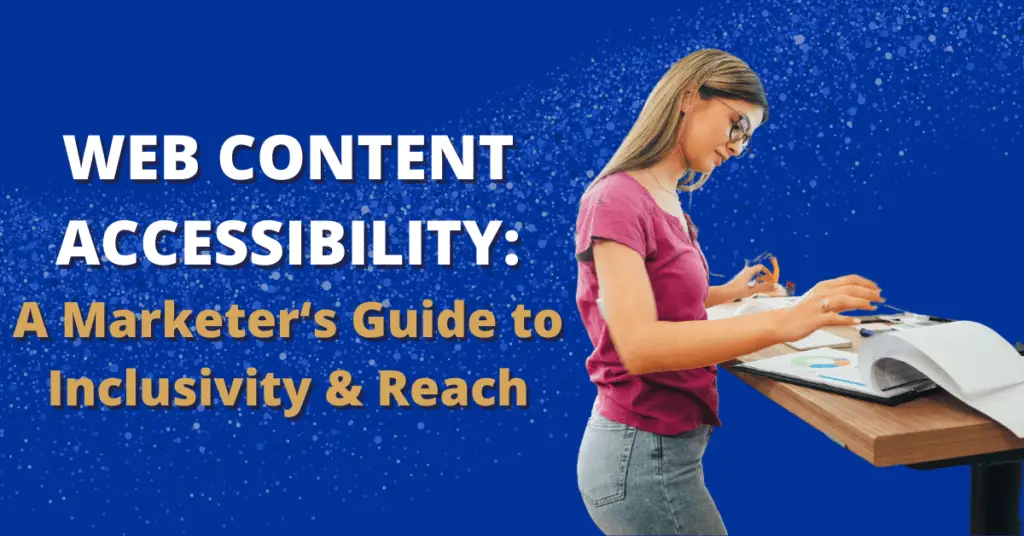
Web content accessibility isn’t just a buzzword—it’s a necessity.
As marketing professionals, we take pride in crafting content that resonates, engages, and ultimately converts our audience. We focus on creating media that speaks to our audience and forms a connection. But we don’t often think about accessibility. Are we missing out on a potential client base by not taking the time to ensure everyone can engage with our content?
Fortunately, there is a straightforward solution. Today, we’ll be breaking down what web content accessibility means for you as a marketing professional and how you can apply these principles to widen your reach and impact.
Why Marketers Should Care About Web Content Accessibility
The basic idea behind web content accessibility is straightforward: everyone deserves to be able to engage with content. However, marketers have additional reasons to prioritize accessibility. Web content accessibility can lead to several notable benefits:
- Expanding audience reach: By ensuring your web content is accessible, you’re complying with legal standards and opening your brand up to a broader audience.
- Enhancing brand reputation: Accessibility reflects your brand’s values. Customers will appreciate your commitment to inclusivity.
- SEO benefits: Search engines favor websites prioritizing accessibility for all users. This boost can undoubtedly help your rankings and visibility.
The Web Content Accessibility Guidelines (WCAG) 2.1
In principle, it’s easy to understand and support web content accessibility. But things get a bit tricky when we try putting those principles into action. What exactly do we need to change? Where do we start? What should we prioritize? The answers to these questions can be found in the Web Content Accessibility Guidelines 2.1, published by the World Wide Web Consortium (W3G).
At its core, the Web Content Accessibility Guidelines (abbreviated WCAG) 2.1 are an internationally recognized set of recommendations designed to make web content more accessible to individuals with disabilities. The disabilities in mind here include but are not limited to visual, auditory, physical, speech, cognitive, language, learning, and neurological disabilities.
These guidelines are categorized into three levels of conformance:
- A: must support
- AA: should support
- AAA: may support
These priority tiers offer a framework to improve accessibility in stages rather than requiring an immediate overhaul.

Practical First Steps for Marketers
Using the WCAG as a guide, we can quickly identify a few first steps your marketing team can take toward full web content accessibility:
- Alt image text: Ensure all images on your website have alternative text descriptions. This not only aids visually impaired users who rely on screen readers but also serves as a context for search engines to index your images more effectively.
- Keyboard navigation: Some users are unable to hold a mouse, but can still use a keyboard. Ensure that they can navigate your entire website using only their keyboard if necessary.
- Contrast and color: Use sufficient color contrast ratios for text and background colors to aid users with visual impairments. Additionally, do not rely solely on color to convey information.
- Video captions/transcripts: Any videos on your website should have captions. Audio-based content without visuals (such as a podcast) should include a transcript. This not only aids users with hearing impairments but also benefits users in sound-sensitive environments.
- Clear language use: Use clear and simple language for content. This is beneficial not just for users with cognitive disabilities, but for all users, especially those for whom English might not be their first language.
- Responsive design: Ensure your website’s design is responsive, meaning it can adapt to various screen sizes and devices. This is crucial for users with low vision and those who rely on mobile devices.
Making Web Content Accessibility a Priority
Web content accessibility is not just about following recommendations. It’s about embracing a comprehensive approach to inclusivity. By implementing WCAG 2.1 guidelines, marketing professionals can not only expand their audience reach but also enhance their brand’s reputation and ethical stance.
If reworking your landing pages, marketing emails, and more for accessibility sounds like a daunting task, don’t worry: you don’t have to do it alone. The team at 4Thought Marketing can help you identify areas where your marketing strategy needs improvement and partner with you to make the necessary changes. Get in touch with us today to learn more.

